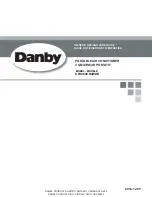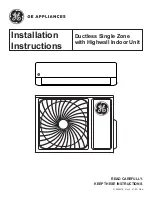
18
JOHNSON CONTROLS
FORM 100.50-NOM6 (1207)
Installation
• Also avoid locations beneath windows or be-
tween structures.
• Optional condenser coil protection should be used
for seashore locations or other harsh environ-
ments.
• The unit should be installed on a roof that is structur-
ally strong enough to support the weight of the unit
with a minimum of defl ection. It is recommended
that the unit(s) be installed not more than 15 feet
from a main support beam to provide proper
structural support and to minimize the transmis-
sion of sound and vibration. Ideally, the center of
gravity should be located over a structural support
or building column.
• Location of unit(s) should also be away from
building fl ue stacks or exhaust ventilators to
prevent possible reintroduction of contaminated
air through the outside air intakes.
• Be sure the supporting structures will not obstruct
the duct, gas or wiring connections.
LOCATION
Of the many factors that can effect the location of
equipment, some of the most important to consider are
Structural, Acoustical and Service clearances. Proper
attention should be made at the design stage to ensure
proper structural support. In cases where equipment is
being replaced, be aware of building design to insure
support is adequate for the application.
The next most important consideration in applying roof
top equipment is that of sound from the equipment.
Special care should be made to keep the roof top unit
away from sound sensitive areas such as conference
rooms, auditoriums and executive offi ces and any other
room that may have potential for tenant occupancy.
Possible locations could be above hallways, mechanical
or utility rooms.
Finally, service clearances should be maintained in
rooftop design to insure safe access to the unit. Unit
clearances are designed so that technicians have enough
space between units, building walls, and edges of
building to gain access safely. In cases where space is
limited, please call your local York representative for
additional information.
The clearances shown are to provide
adequate condenser airfl ow and ser-
vice access to inside the unit. Addi-
tional clearance should be considered
for component replacement such as
compressors, evaporator coils, and
supply or exhaust fans.
While it is a common practice to op-
erate the fan as soon as possible (air
movement during construction) on the
job site, the incomplete ductwork and
missing diffuser grilles will greatly
reduce air resistance and will allow
the fan to operate beyond design pa-
rameters. This practice may result in
water carry over and fl ooding of the
unit. Also, the supply fan motor may
overamp and become damaged.
FIG. 2-1 – UNIT CLEARANCES
LD13267
NOTES:
1. 10' clearance minimal over the top of the condensing unit.
2. Only one adjacent wall can exceed unit height.
3. 12' clearance required to adjacent units.
4. 8' service access recommended on one side.
5. Economizer and exhaust hoods, where applicable, are folded
inside unit for shipment.
6. Dim. is to outside of lifting lugs.
96"
Summary of Contents for ECO2 YPAL 050
Page 62: ...62 JOHNSON CONTROLS FORM 100 50 NOM6 1207 THIS PAGE INTENTIONALLY LEFT BLANK...
Page 113: ...113 JOHNSON CONTROLS FORM 100 50 NOM6 1207 6 ECONOMIZER EXHAUST LD13018...
Page 114: ...114 JOHNSON CONTROLS FORM 100 50 NOM6 1207 User Interface Control Center FANS LD13019...
Page 115: ...115 JOHNSON CONTROLS FORM 100 50 NOM6 1207 6 COOLING SETUP LD13020...
Page 117: ...117 JOHNSON CONTROLS FORM 100 50 NOM6 1207 6 HEATING SETUP LD13022...
Page 119: ...119 JOHNSON CONTROLS FORM 100 50 NOM6 1207 6 SYSTEM OPTIONS LD13024...
Page 121: ...121 JOHNSON CONTROLS FORM 100 50 NOM6 1207 6 INPUTS COMFORT DEMAND VENTILATION LD13014 LD13026...
Page 125: ...125 JOHNSON CONTROLS FORM 100 50 NOM6 1207 6 ALARMS LD13031...
















































